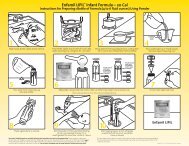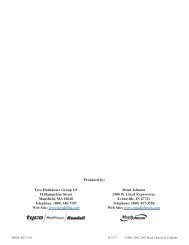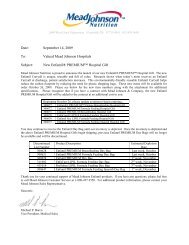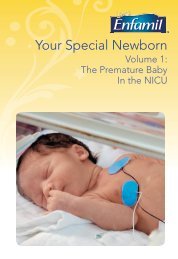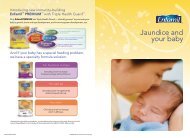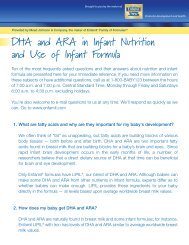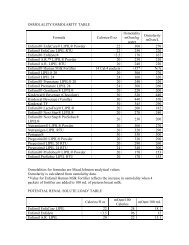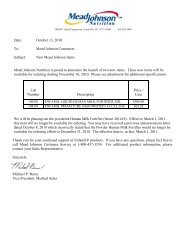LB2882MaternalNutriti+ - Mead Johnson Nutrition
LB2882MaternalNutriti+ - Mead Johnson Nutrition
LB2882MaternalNutriti+ - Mead Johnson Nutrition
Create successful ePaper yourself
Turn your PDF publications into a flip-book with our unique Google optimized e-Paper software.
Iron<br />
Iron is vital to the production of hemoglobin, (which is necessary for oxygen transport), and energy production,<br />
fetal immunity, and development of the central nervous system. 106 Iron deficiency affects more than 2 billion people<br />
globally, making it the most common nutrient deficiency in the world. Iron deficiency is more common in developing<br />
countries but continues to be a significant problem in developed countries despite near elimination of other forms<br />
of malnutrition. 107 An estimated eight million women of childbearing age in the US have iron-deficiency anemia, 2 and<br />
it is reasonable to expect that a large number of women are also iron-deficient. Low-income, less than 12 years of<br />
education and increased parity are all associated with a greater risk of iron deficiency and iron-deficiency anemia. 42,108<br />
The global prevalence of iron-deficiency anemia is estimated to be 47.4% in pregnant women. 18<br />
The recommended iron intakes established by the IOM increase from 18 mg/day to 27 mg/day during pregnancy<br />
for women ages 19 to 50 years 20 while the WHO has established different recommended intakes based on the<br />
bioavailability of dietary iron consumed. In developing countries, it is reasonable to use iron bioavailability levels of 5%<br />
and 10% translating into recommended nutrient intakes for lactating women of 30 and 15 mg/day respectively. In<br />
developed countries consuming a more Western diet, it is more appropriate to use bioavailability levels of 12% and<br />
15%, translating into recommended nutrient intakes for lactating women of 12.5 and 10 mg/day of iron, respectively.<br />
The WHO establishes no recommended nutrient intakes for iron in pregnant women because the iron balance in the<br />
diet depends on amounts of stored iron in addition to the bioavailability of dietary iron. 21<br />
Iron stores at the time of conception are a strong indicator of risk for iron-deficiency anemia later in pregnancy. 42<br />
Serum ferritin levels are a measure of stored iron in the body and can be used with a hematocrit to confirm irondeficiency<br />
anemia when there is no evidence of inflammation 108 before and during pregnancy. Iron-deficiency anemia<br />
during pregnancy has been associated with an increased risk for preterm birth, low birth weight, and perinatal<br />
mortality. 109-111 However, results of recent studies on the effects of maternal iron status and supplementation during<br />
pregnancy on fetal growth have been inconsistent. In a recent review on iron supplementation and pregnancy<br />
outcome, studies starting supplementation in mid- or late pregnancy found an increase in maternal iron markers,<br />
but no effect on fetal growth with the exception of one study where high-dose supplementation showed a<br />
positive association with birth length (not with birth weight) in a low-income setting. However, in studies starting<br />
supplementation in early pregnancy, maternal iron status did not improve, but there was a beneficial effect on fetal<br />
growth. 112<br />
Iron absorption during pregnancy is determined by several factors including the amount and bioavailability of<br />
dietary iron as well as the changes in iron absorption that occur during pregnancy. Although there is an increase in<br />
iron absorption, it is difficult for the mother to consume enough dietary iron to meet her iron requirements during<br />
pregnancy. 21 The typical American diet provides inadequate iron to meet the recommendations for the pregnancy<br />
state. 113 In addition, the endogenous iron stores of women may be insufficient to provide for the increased iron<br />
demands of pregnancy. 65<br />
In the US, the CDC recommends that all pregnant women take 30 mg of supplemental elemental iron every day<br />
to prevent anemia 2 and 60 to 120 mg of elemental iron daily to treat anemia once it is diagnosed. 2,113 In the UK,<br />
prophylactic iron supplementation is not recommended for pregnant women. However, pregnant women are<br />
monitored throughout pregnancy for iron-deficiency anemia and recommendations for supplementation based on iron<br />
status tests are established. 107 There is some concern that such prophylactic iron supplementation in women without<br />
anemia or iron-deficiency anemia may increase the risk of pregnancy complications. 42 However, iron supplementation<br />
during pregnancy has merit, as a large proportion of women have difficulty maintaining iron stores during pregnancy<br />
and are at risk for anemia. 113 The WHO recommends that pregnant women be supplemented with 60 mg iron in<br />
conjunction with 400 µg of folic acid daily. 18<br />
19







